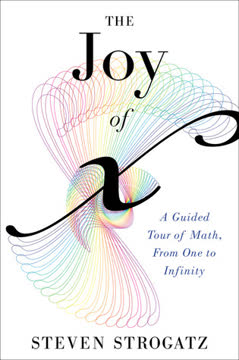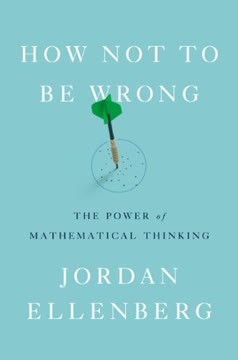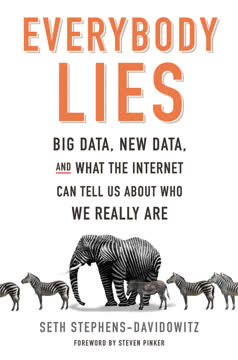نکات کلیدی
1. عدم قطعیت همهجا حاضر است: قانون فرانکلین را بپذیرید
در این دنیا هیچ چیز قطعی نیست جز مرگ و مالیات.
توهم قطعیت. بسیاری از مردم باور دارند که فناوریهای مدرن مانند آزمایش DNA، اثر انگشت و غربالگری پزشکی قطعیت مطلق را فراهم میکنند. اما این یک توهم است. همه این روشها در معرض خطاها و عدم قطعیتها هستند.
قانون فرانکلین. نقل قول معروف بنجامین فرانکلین به ما یادآوری میکند که تقریباً همه چیز در زندگی شامل درجهای از عدم قطعیت است. شناخت این واقعیت اولین گام در تصمیمگیری بهتر در شرایط عدم قطعیت است.
پیامدهای نادیده گرفتن عدم قطعیت:
- احساس امنیت کاذب
- نادیده گرفتن خطاهای احتمالی یا توضیحات جایگزین
- تصمیمگیریهای ضعیف بر اساس اطلاعات ناقص
2. بر بیسوادی آماری غلبه کنید تا تصمیمات بهتری بگیرید
بهترین فناوری ارزش کمی دارد اگر مردم آن را درک نکنند.
بیسوادی آماری. بسیاری از مردم، از جمله حرفهایها در زمینههایی مانند پزشکی و حقوق، با مفاهیم آماری پایه مشکل دارند. این بیسوادی میتواند به تصمیمگیریهای ضعیف و تفسیر نادرست اطلاعات مهم منجر شود.
سه نوع بیسوادی آماری:
- ناآگاهی از خطر: ندانستن خطرات مرتبط
- ارتباط نادرست خطر: ناتوانی در برقراری ارتباط مؤثر خطرات
- تفکر مبهم: دشواری در استنتاج صحیح از اطلاعات آماری
غلبه بر بیسوادی آماری:
- اهمیت تفکر آماری در زندگی روزمره را بشناسید
- یاد بگیرید از ابزارهای ساده برای درک و برقراری ارتباط خطرات استفاده کنید
- تمرین تفسیر اطلاعات آماری در زمینههای مختلف
3. فرکانسهای طبیعی از احتمالات شهودیتر هستند
هشت نفر از هر ۱۰۰۰ زن به سرطان سینه مبتلا هستند. از این ۸ زن مبتلا به سرطان سینه، ۷ نفر نتیجه ماموگرافی مثبت خواهند داشت. از ۹۹۲ زن باقیمانده که سرطان سینه ندارند، حدود ۷۰ نفر همچنان نتیجه ماموگرافی مثبت خواهند داشت.
فرکانسهای طبیعی در مقابل احتمالات. فرکانسهای طبیعی برای اکثر مردم قابل فهمتر و کار با آنها آسانتر از احتمالات است. آنها نشان میدهند که چگونه انسانها به طور طبیعی اطلاعات آماری را از طریق تجربه درک میکنند.
مزایای فرکانسهای طبیعی:
- محاسبات پیچیده را ساده میکنند
- نرخهای پایه را آشکارتر میسازند
- کاهش سردرگمی و خطاها در استدلال آماری
مثال: در تشخیص پزشکی، ارائه نتایج آزمایش با استفاده از فرکانسهای طبیعی (مثلاً "۷ نفر از ۷۷ زن با ماموگرافی مثبت به سرطان سینه مبتلا هستند") شهودیتر از استفاده از احتمالات (مثلاً "احتمال ابتلا به سرطان سینه با توجه به ماموگرافی مثبت ۹٪ است") است.
4. خطر نسبی در مقابل خطر مطلق: زمینه در ارتباط خطرات اهمیت دارد
کاهش خطر نسبی بیشتر از کاهش خطر مطلق چشمگیر به نظر میرسد.
ارتباط نادرست خطرات. ارائه خطرات به صورت نسبی اغلب به برآورد بیش از حد مزایا یا مضرات منجر میشود. کاهش خطر مطلق تصویر دقیقتری از تأثیر واقعی ارائه میدهد.
مثال: درمانی که خطر بیماری را از ۴ به ۳ در ۱۰۰۰ نفر کاهش میدهد میتواند به صورت زیر توصیف شود:
- کاهش خطر نسبی: ۲۵٪ (چشمگیر به نظر میرسد)
- کاهش خطر مطلق: ۰.۱٪ (مزیت را در چشمانداز قرار میدهد)
- تعداد مورد نیاز برای درمان: ۱۰۰۰ (توضیح میدهد که چند نفر باید درمان شوند تا یک نفر بهرهمند شود)
بهترین روشها:
- ارائه هر دو خطر نسبی و مطلق
- استفاده از فرکانسهای طبیعی در صورت امکان
- ارائه زمینه برای کمک به درک مردم از بزرگی خطرات
5. غربالگری پزشکی: مزایا را در مقابل مضرات احتمالی بسنجید
امیدوارم که فشاری بر زنان برای حضور در [غربالگری سرطان سینه] وارد نشود. تصمیم باید از آنها باشد و اطلاعات واقعی باید در دسترس عموم و بیمار فردی قرار گیرد.
رویکرد متعادل به غربالگری. در حالی که غربالگری پزشکی میتواند بیماریها را زود تشخیص دهد، همچنین با مضرات احتمالی مانند نتایج مثبت کاذب، تشخیص بیش از حد و درمان غیرضروری همراه است.
هزینههای غربالگری سرطان سینه:
- نتایج مثبت کاذب: اضطراب، آزمایشهای اضافی، بیوپسیهای غیرضروری
- تشخیص بیش از حد: درمان سرطانهای کند رشد که ممکن است هرگز علائمی ایجاد نکنند
- قرار گرفتن در معرض اشعه: خطر کوچک سرطان ناشی از اشعه
مزایای غربالگری سرطان سینه:
- کاهش احتمالی مرگ و میر ناشی از سرطان سینه (برای زنان بالای ۵۰ سال)
- تشخیص زودتر ممکن است به گزینههای درمانی کمتر تهاجمی منجر شود
تصمیمگیری آگاهانه: بیماران باید با اطلاعات واضح و متعادل درباره هر دو مزایا و خطرات غربالگری برای تصمیمگیری شخصی بر اساس ارزشها و ترجیحات خود ارائه شوند.
6. شواهد DNA: زنجیره استنتاج را درک کنید
گزارش تطابق تضمین نمیکند که متهم مجرم است یا حتی منبع اثر است.
زنجیره استنتاج در شواهد DNA:
- تطابق گزارش شده
- تطابق واقعی
- منبع اثر
- حضور در صحنه جرم
- گناه
خطاها و عدم قطعیتهای احتمالی:
- خطاهای آزمایشگاهی (نتایج مثبت کاذب)
- تطابقهای تصادفی
- آلودگی یا انتقال DNA
- حضور در صحنه جرم همیشه به معنای گناه نیست
اشتباه دادستان: اشتباه گرفتن احتمال تطابق با توجه به بیگناهی با احتمال بیگناهی با توجه به تطابق. این خطا میتواند به برآورد بیش از حد قدرت شواهد DNA منجر شود.
بهترین روشها:
- ارائه شواهد DNA با استفاده از فرکانسهای طبیعی
- توضیح واضح زنجیره استنتاج و عدم قطعیتهای احتمالی
- در نظر گرفتن توضیحات جایگزین برای تطابقهای DNA
7. درک خطر: شناخت سوگیریها و سوءتفاهمهای رایج
آنچه جان کیو پابلیک بیشتر از آن میترسد همیشه آن چیزی نیست که بیشتر او را تهدید میکند.
عوامل مؤثر بر درک خطر:
- آمادگی: تمایل تکاملی به ترس از تهدیدات خاص
- بلایا: ترس بیشتر از رویدادهایی که میتوانند به مرگهای زیادی منجر شوند
- خطرات ناشناخته: ترس از خطرات جدید و ناآشنا
سوءتفاهمهای رایج:
- برآورد بیش از حد خطرات رویدادهای نادر اما دراماتیک (مثلاً سقوط هواپیما)
- برآورد کمتر از حد خطرات رویدادهای رایج اما کمتر دراماتیک (مثلاً تصادفات خودرو)
- تمرکز بر خطرات نسبی بدون در نظر گرفتن خطرات مطلق
بهبود درک خطر:
- جستجوی اطلاعات آماری دقیق
- در نظر گرفتن هر دو احتمال و تأثیر بالقوه خطرات
- آگاهی از نحوه ارائه و ارتباط خطرات
8. رضایت آگاهانه نیازمند ارتباط واضح خطرات و مزایا است
دنیای خاموش بین پزشک و بیمار یکی از دلایل است: بیماران اغلب نمیدانند چه سوالاتی بپرسند.
موانع رضایت آگاهانه:
- توهم قطعیت: ارائه درمانها به عنوان قطعی به جای پذیرش عدم قطعیتها
- بیسوادی آماری: دشواری درک و برقراری ارتباط اطلاعات آماری
- محدودیتهای زمانی: زمان محدود برای بحثهای عمیق
- عدم تعادل قدرت: بیماران ممکن است در پرسش از اقتدار احساس ناراحتی کنند
بهبود رضایت آگاهانه:
- استفاده از زبان واضح و قابل فهم برای توضیح خطرات و مزایا
- ارائه اطلاعات با استفاده از فرکانسهای طبیعی و خطرات مطلق
- تشویق بیماران به پرسیدن سوالات و بیان نگرانیها
- ارائه اطلاعات متعادل درباره درمانهای جایگزین
تصمیمگیری مشترک: درگیر کردن بیماران در فرآیند تصمیمگیری با در نظر گرفتن ارزشها، ترجیحات و اهداف آنها در کنار شواهد پزشکی.
9. تبدیل بیسوادی آماری به بینش از طریق نمایشهای مناسب
حل یک مسئله به سادگی به معنای نمایش آن به گونهای است که راهحل شفاف شود.
قدرت نمایش. نحوه ارائه اطلاعات میتواند به طور قابل توجهی بر درک و تصمیمگیری تأثیر بگذارد. نمایشهای مناسب میتوانند بیسوادی آماری را به بینش تبدیل کنند.
نمایشهای مؤثر:
- فرکانسهای طبیعی به جای احتمالات
- خطرات مطلق به جای خطرات نسبی
- کمکهای بصری (مثلاً درختان فرکانس، آرایههای آیکون)
- مثالها و تشبیههای ملموس
مزایای نمایشهای واضح:
- تسهیل درک مفاهیم آماری پیچیده
- کاهش خطاها در استدلال و تصمیمگیری
- توانمندسازی افراد برای انتخابهای آگاهانه
آموزش و ارتباطات: آموزش تفکر آماری با استفاده از نمایشهای شهودی میتواند سواد آماری را در زمینههای مختلف، از جمله پزشکی، حقوق و سیاست عمومی بهبود بخشد.
آخرین بهروزرسانی::
FAQ
What's Calculated Risks: How to Know When Numbers Deceive You about?
- Exploration of Uncertainty: The book delves into how humans perceive and handle uncertainty and risk, especially in medical and legal contexts. It stresses the need to understand statistical information for informed decision-making.
- Real-Life Illustrations: Gerd Gigerenzer uses examples like HIV testing and breast cancer screening to show how miscommunication of risks can have serious consequences, highlighting the gap between statistical data and public understanding.
- Practical Tools: The author introduces tools such as using natural frequencies instead of probabilities to help individuals better comprehend risks and make informed choices.
Why should I read Calculated Risks by Gerd Gigerenzer?
- Improve Decision-Making: The book enhances your ability to understand and communicate risks, crucial in today's data-driven world, equipping you to navigate uncertainties effectively.
- Awareness of Miscommunication: It highlights how professionals often miscommunicate risks, leading to unnecessary fear and anxiety, and helps you advocate for clearer communication in healthcare and legal contexts.
- Empowerment Through Knowledge: By learning about statistical principles, readers can feel more empowered to question and understand information presented to them in various settings.
What are the key takeaways of Calculated Risks?
- Understanding Uncertainty: Recognizing uncertainty as a fundamental aspect of life can help individuals make better decisions, as emphasized by Gigerenzer.
- Natural Frequencies vs. Probabilities: The book advocates using natural frequencies to communicate risks more effectively, clarifying actual risks involved.
- Illusion of Certainty: Gigerenzer discusses how the illusion of certainty can lead to poor decision-making, encouraging readers to embrace uncertainty.
What are the best quotes from Calculated Risks and what do they mean?
- “Dare to know!”: This quote encourages individuals to seek knowledge and understanding of risks, promoting critical thinking and informed decision-making.
- “Nothing is certain but death and taxes.”: It serves as a reminder of life's inherent uncertainty, setting the tone for discussions on navigating uncertainties.
- “The best technology is of little value if people do not comprehend it.”: This highlights the importance of understanding tools and technologies, especially in healthcare, underscoring the need for clear communication of risks.
How does Gerd Gigerenzer define "innumeracy" in Calculated Risks?
- Definition of Innumeracy: Gigerenzer defines it as the inability to reason appropriately about uncertainties and risks, particularly in statistical contexts, reflecting a lack of understanding of basic mathematical concepts.
- Forms of Innumeracy: The book identifies forms like ignorance of risk, miscommunication of risk, and clouded thinking, each contributing to poor decision-making.
- Impact on Decision-Making: Innumeracy can lead to significant consequences, such as unnecessary medical procedures or flawed legal judgments, emphasizing the need for education and tools to combat this issue.
What is the significance of using natural frequencies instead of probabilities in Calculated Risks?
- Clarity in Communication: Natural frequencies provide a clearer representation of risks, making it easier for individuals to understand statistical data's actual implications.
- Reduction of Miscommunication: Using natural frequencies minimizes potential miscommunication by specifying the reference class clearly, as illustrated in the Prozac example.
- Facilitating Better Inferences: Gigerenzer argues that natural frequencies help individuals make better inferences about risks, aligning more closely with how humans naturally process information.
How does Calculated Risks address the issue of informed consent?
- Importance of Informed Consent: The book emphasizes that informed consent is crucial in medical and legal contexts, requiring clear communication of uncertainties.
- Challenges in Achieving Informed Consent: Gigerenzer discusses barriers like the illusion of certainty and professionals withholding information, highlighting the need for transparency.
- Recommendations for Improvement: The author suggests educating both patients and professionals about risks and decision-making processes, using natural frequencies and comprehensive information.
What role do experts play in the miscommunication of risks, according to Calculated Risks?
- Expert Misunderstanding: Gigerenzer points out that even experts can misinterpret statistical information, leading to miscommunication of risks.
- Influence on Public Perception: Experts' miscommunication can significantly impact public perception and decision-making, as seen in HIV testing and breast cancer screening cases.
- Need for Better Training: The book advocates for better training of experts in statistical reasoning and communication to foster clearer communication and better decision-making.
How does Gerd Gigerenzer illustrate the concept of the "prosecutor's fallacy" in Calculated Risks?
- Definition of Prosecutor's Fallacy: It occurs when the probability of a match is incorrectly equated with the probability of guilt, leading to wrongful convictions.
- Case Examples: Gigerenzer uses the case of People v. Collins to illustrate this fallacy, where statistical probabilities were misapplied, leading to a reversed conviction.
- Implications for Justice: The book highlights the dangers of this fallacy in the legal system, emphasizing the need for clearer statistical communication to prevent similar errors.
What are the psychological impacts of miscommunication of risks as discussed in Calculated Risks?
- Fear and Anxiety: Miscommunication of risks can lead to heightened fear and anxiety, as seen in false HIV test results, causing significant emotional distress.
- Impact on Decision-Making: The psychological toll can affect decision-making processes, leading to choices based on fear rather than informed understanding.
- Need for Supportive Counseling: Gigerenzer emphasizes supportive counseling that addresses both emotional and informational needs, helping mitigate anxiety and empower informed decisions.
What are the common misconceptions about breast cancer screening discussed in Calculated Risks?
- False Positives: Many women experience false positive results in mammography screening, leading to unnecessary anxiety and procedures.
- Relative vs. Absolute Risk: The book explains the difference, emphasizing that absolute risk reduction provides a clearer picture of screening benefits.
- Mortality Reduction: Gigerenzer discusses the misconception that early detection always reduces mortality, pointing out that total mortality was the same in screening and control groups.
What role does the media play in shaping public perception of risks according to Calculated Risks?
- Influence of Reporting: Media coverage can significantly impact public understanding of risks, often emphasizing sensational stories over statistical realities.
- Miscommunication of Statistics: The media often presents statistics in misleading ways, such as focusing on relative risks without context, creating an illusion of certainty.
- Responsibility of Journalists: Gigerenzer calls for greater responsibility among journalists to report risks accurately and clearly, fostering a more informed public.
نقد و بررسی
کتاب ریسکهای محاسبهشده به دلیل بررسی عمیق و دقیق خود در زمینهی استدلال آماری و ارتباطات ریسک، عمدتاً نقدهای مثبتی دریافت میکند. خوانندگان از توضیحات روشن گیگرنزر دربارهی مفاهیم پیچیده و مثالهای واقعی کتاب از حوزههای پزشکی و حقوق قدردانی میکنند. بسیاری آن را برای درک احتمال و عدم قطعیت چشمگشا و ارزشمند میدانند. برخی کتاب را به دلیل تکراری بودن یا پیچیدگی انتقاد میکنند، اما بهطور کلی، منتقدان اهمیت آن را در کمک به مردم برای تفسیر آمار و اتخاذ تصمیمات آگاهانه تحسین میکنند. تأکید کتاب بر استفاده از فراوانیهای طبیعی برای توضیح ریسکها بهعنوان بخشی بسیار مفید برجسته میشود.
Similar Books

















